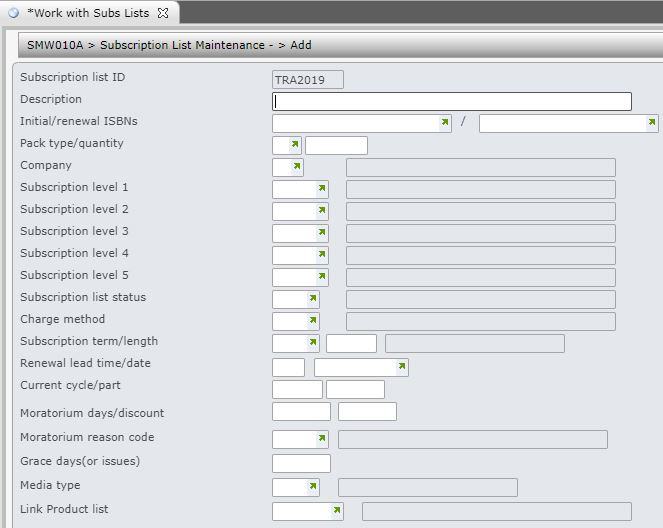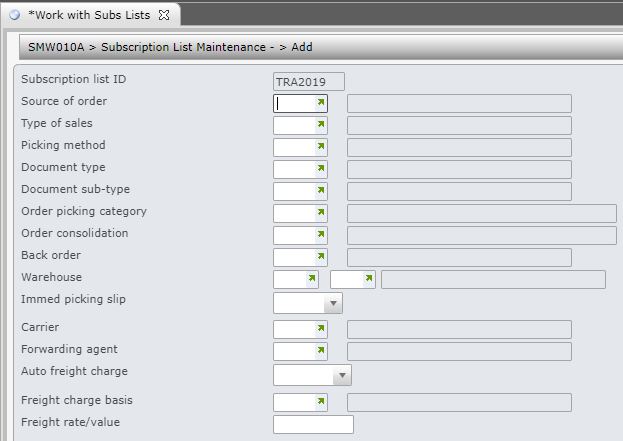Subscription module supports multiple product types and formats such as books, CDs, online subscriptions etc. Subscribers are grouped into lists (subscription lists) depending on the characteristics of their subscription. For example, two subscribers subscribing to the same product will be on different lists if one is subscribing for one year and the other is subscribing for six months. Subscription List Maintenance is used create new subscription lists.
Online subscription lists are created by specifying the Media Type = ONL (Online). An online subscription order requires an additional contact. This additional contact will be responsible in administering the subscription including the application of user seats for named subscriptions.
Event based subscription can be renewed by time or by event. If a subs term is defined with time definition on TMSSM/SL-STRMT, the subscription will be renewed by time. If no time definition, it will be renewed by event. The field Remaining Issues on subscription order file will be used to determine when to renew.
For time based renewal subs, subs renewal lead time is number of months. For event based renewal subs, subs renewal lead time is number of issues left to renew.
Add a subscription list
- In the menu, expand Publishing Modules > Subscriptions Management > Subs Maintenance and then double-click Work with Subs Lists. SMW005 Subscription List Selection panel appears.
- Click OK on the selection panel. SMW005 Subscription List Maintenance main panel appears.
- Click Add to add a new subscription list.
- Enter the Subscription list ID for the new list and click OK. SMW010 Subscription List Maintenance panel appears in Add mode.
| Field | Description | |
| Subscription list ID | A name or code to be used to identify this Subscription List (Sub List) is required. This name usually relates to the title being subscribed to and if the title comes in a number of formats like CD, tape, hardcover, softcover, etc. a Subscription List for each one of these titles needs to be created. This is not the ISBN set up on the Title Masterfile but rather a similar code to easily identify the products being supplied. The actual ISBN can be used as a Subscription List Identification if it is the company preference. To denote the format options, the same core number can be used with a suffix of say C for CD and O for On-line, etc. This Sub List ID code can be a maximum of 8 alphanumeric characters. For example: SIMC for Simms Court Practice In Release Run Management, if a specific Subscription List is required the List Id can be entered. Leave the field blank to select all Subscription Lists. When releasing subscription orders, enter the Subscription List to be used for the release. Multiple Subscription Lists can be used with one Product List. |
|
| Description | Enter a meaningful description of the subscription list being created. | |
| Initial/renewal ISBN’s | It is possible to search and enter values for Initial and Renewal ISBN’s. | |
| Pack type/quantity | N=Normal or P=Pack to determine the type of subscription list being created. Prompt and select a valid pack type. Enter the quantity of components that make up the pack. | |
| Company | Company specific subs lists can be created. | |
| Subscription levels 1-5 | There are 5 levels of analysis available on each Subscription List. These analysis levels can be used in the initial selection screen to display only those subscription lists belonging to the range entered. These classifications are a means of grouping Subscription Titles or Lists for reporting purposes. The way Subscription Lists are grouped is normally in the same way as the title has been classified. For example, level 1 could denote the division of the company. For example, level 2 could be used for the type of product within a division of the company. Or another example of the use of this level of the subscription hierarchy could be codes relating to Titles to facilitate Title Grouping. If products are split across Subscription Lists according to the format in which they are produced, to report on a specific Title no matter what the format, a Title Group would be selected. The medium in which products are available could be important reporting criteria. |
|
| Subscription list status | A Subscription List needs to be flagged as Active for it to be included in the Release or Bulk Run. For a new list, the status must be A. This status can be maintained at any time. When a subscription list is closed, if there is any active subs order on the subs list, SMW010 will issue a warning and close those subs orders if control file TMSSM/RULE-CLS is setup. |
|
| Charge method |
|
|
| Subscription term | A Term Type code is used to indicate the subscription interval. This is expressed as a number of months, a number of updates, a number of issues, a number of parts or a number of pages. It really only applies to Pay In Advance subscriptions and defines what the customer has paid for, in advance. For example: 12 months or 6 parts or 1500 pages or 1 Issue. Other parameters relating to the Subscription Term Type are whether or not the Term is Event based or Time based. Event based could include despatching updates or issues of a volume or pages of a publication as and when they are made available. The publications are sent and paid for at the same time. This would apply to Pay As You Go subscriptions. An Event based Term Type such as Page or Part is only flagged as an event and the Term Type is not applicable. Time based is when issues of a publication are sent out on a regular basis for a period of time. Time based would be an anniversary Pay in Advance type of subscription. For example a Term Type of Half Year is a time base in months and the number of months is 6. So every 6 months a release 16 could be due. The Term entered is also used as a revenue recognition period length. |
|
| Subscription length | Depending on the Subscription Term Type entered previously, this field indicates the number of charges relating to the Term Type selected. For example if the Term Type is 1 Year, the time base is in months and the entry here would be 12. Every month a release is due. Or in the case of the Term Type being an issue, the length could be 1 indicating the release is done, or a charge is made per issue. | |
| Renewal lead time | Depending on the renewal requirements, the Renewal Lead Lime is the number of months prior to the end of a subscription term (anniversary date), a renewal notice or invoice is to be sent out. So for example, one month in advance of renewal falling due would have an entry in this field of 1. The revenue received in advance is deferred and only realised when applicable.
If renewal notices/invoices are to be sent out at a specific time, the actual date when the paperwork is to be produced is to be entered in the next field and no lead time is required. This is only applicable to a PIA Fixed Charge Method. |
|
| Renewal date | This is the specific date on which renewal notices are to be sent out. For Renewal Product Lists, when a release is finalised, the system checks the Charge Method and Term Type and calculates the next renewal date on either the header or all the orders – for time based subscriptions. The header date is updated in the case of fixed renewals and the order level renewal date is updated in the case of anniversary renewals. The system runs an error check for ‘subscription renewal date is before today’ when the next renewal date is older than today. This is necessary in order to minimise entry errors. | |
| Current cycle/part |
The current billing cycle and the last part issued within this billing cycle are recorded in these two fields. For example when a release is processed for an event based subscription, the issue number dispatched in the release is stored here. This issue number increases with each new issue released. When all issues for the cycle have been released, the cycle number increases to the next cycle. So for example, the entry in the Cycle field is 1999, the year in which the cycle starts. If the subscription starts at the beginning of the year the issue number is 1. When the issue number is 12, the Billing cycle increases to 2000 as the Subscription Term was for 1 Year. If the subscription is for a number of pages, the Cycle number can be entered as 1. The Term Length indicates the number of pages to be received on this sub list before a new cycle is created.The entry made on the Product List determines how to increase the cycle. When a new subscription is established, the current part number of a volume. |
|
| Moratorium days |
Enter the number of moratorium days applied to new subscribers to the list. This is a period of time, usually immediately following a new sale, where customers are not charged for issues or updating material normally involving a charge or where payment is suspended for a period of time. The actual moratorium period is usually dependent on the subscription title involved and is for Pay As You Go subscriptions only. The start of the moratorium period is based on the Subscription Start Date allocated when customers are registered on the Sub List via the Order Maintenance function. If a moratorium does not apply, leave this field blank. |
|
| Moratorium discount |
Moratorium discount rate is the percentage of price reduction applicable for moratorium period. If it is a no charge moratorium, the discount rate is 100%. If a Moratorium does not apply, leave this field blank. |
|
| Moratorium reason code | This is the moratorium reason code to indicate why a moratorium is applicable. User defined moratorium reasons are defined in Control file TMSSM/SL-SMOS. If a Moratorium does not apply, leave this field blank. | |
| Grace days (or issues) | Enter the default period of grace allowed for a customer to pay for a subscription renewal before the subscription is cancelled. This is expressed as a number of days from the renewal date. When the current term of the subscription expires, the system changes the subscription status to grace and uses this grace period to keep the subscription active until it is paid. The subscription status is changed to active. The status change to active is a manual process activated by a notification where payment has been received. If the subscription is not made active, then it ceases to release orders for the customer after the grace period and changes to status closed. This default can be overridden for individual customers. | |
| Media type |
This field is used to indicate if the subscription is paper based or an on-line subscription. For online subscription, you will need to specify on the order the online access type, which is defined in Control file TMSSM/SL-OLAT. If media type is ONL=Online then the charge method must be set as C=”PIA Anniversary” and subscription term be set with a time based term i.e. Month, Year, etc. |
|
| Link product list | A product list can be linked to a subscription list, as long as the product list is active. |
- Enter all the necessary information on this panel and click Page down.
| Field | Description |
| Source of order | Select a user defined code from the control file TMSDS/TR-SRCT to indicate what external source the orders come from. |
| Type of sale | Select a user defined code from the control file TMSDS/TR-TOS to indicate the type of sale. |
| Picking method | A valid picking method indicating the warehouse method for picking and despatching the goods. |
| Document type | This field is part of the Subscription Order Release selection. This is a valid document type code indicating the transaction method used for subscriptions. A =Invoice is the only selection allowed. |
| Document sub-type | This code is important to the warehouse as it assists them with the management of their picking slip releases for efficient picking. This field is part of the Subscription Order Release selection. The possible doc sub-types are defined in control file TMSSM/SL-DST. |
| Order picking category | These categories are user defined and can be setup according to the Subscription Lists if it is the most efficient way for the warehouse to handle the picking of releases. An Order Category can identify a Subscription Release as opposed to a Sales Order Processing release. |
| Order consolidation | This Order Consolidation field indicates to the system whether or not orders can be merged with any other orders or released backorders currently held in the system. This allows a single delivery of two or more orders to the one site.
Y= allow consolidation (order merge) of this order with any other order meeting the same criteria. N= merging orders is not allowed. If orders are to be merged, this must be taken into account when designing stationery layouts. Orders merge with the auto freight flag of Y, or with an auto freight flag of N (if all other merge conditions apply). Orders with an auto freight flag of ‘M’ do not merge. The auto freight flag is set in the customer masterfile. |
| Back order |
The code selected here determines how to manage any backorders when a Subscription List is released. A customer could have an overriding requirement and this is setup in the Orders Maintenance section of Sub Lists. Subscription backorders go through the normal sales backorder release process. A=Only accepts backorders for those titles which have not yet been published. B=Only accepts backorders for order to orders. C=Only accepts backorders for those titles which have not yet been published and order to orders. D=Only accepts backorders for those titles awaiting release. N=Does not accept backorders. If the ordered stock quantity is unavailable at the time of order entry or a bulk run, the order is not processed and is considered a lost order. O=Only accepts one backorder for the selected title and customer. The system deletes all existing backorders found for the selected title and customer. Y=Accepts backorders. Stock is automatically backordered if insufficient or no stock is available at the time of order entry. This field is part of the Subscription Order Release selection. |
| Warehouse | This field identifies the location from where the goods should be picked for orders placed by customers. A warehouse defaults and can be overridden. This field is part of the Subscription Order Release selection. |
| Immed picking slip |
In Subscription List Maintenance, whether a Picking Slip is to print immediately or not is recorded. Depending on the type of bulk run being processed, this flag can be changed. For a release dispatching ISBNs, this flag should remain as No as the warehouse should be left in charge of releasing picking slips as and when they choose to. For a renewal run, immediate documents can print, as this has no impact on stock movement. Yes to print immediately or No immediate print. |
| Carrier | Enter the carrier code for this Subscription List. If left blank, the carrier code is taken from the customer order details. An entry here will override the customer order. |
| Forwarding agent | Enter the forwarding agent code, if applicable. |
| Auto freight charge | Determines freight charge applicability. Yes to indicate the subscription order is to automatically be charged freight costs, or No, no freight is to be charged, or Manual to indicate manual freight charges apply. Select Blank and the auto freight charge from the customer order details is used. If the choice is for Manual, the next two fields Freight charge basis and Freight rate value need to be completed. |
| Freight charge basis | This field needs to be completed for a Manual freight charge basis. Usually, the freight charge basis would be F for Fixed. In the next field, indicate what the fixed rate is. |
| Freight rate value |
Enter the freight rate or value for a Manual freight charge basis. If the Freight Charge Basis previously entered was F for Fixed, enter the fixed amount. For example: $3.50. If Weight was selected as the Freight Charge Basis, enter the dollars per kg here. |
- Enter all the relevant information.
- Click OK to save the new subscription list.



